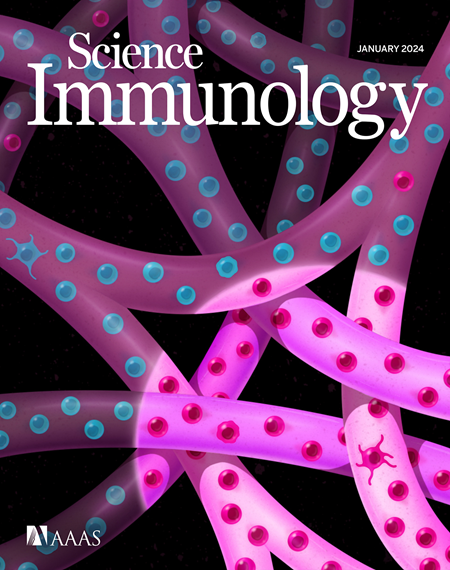肥大细胞衍生的 BH4 和血清素是术后疼痛的关键介质。
IF 16.3
1区 医学
Q1 IMMUNOLOGY
引用次数: 0
摘要
大多数患者在接受大手术后都会出现术后疼痛,并有可能转变为慢性疼痛。目前的治疗方法副作用大、疗效有限,因此需要新的治疗方案。我们观察到皮肤损伤后代谢物 BH4 和血清素的含量增加。肥大细胞是术后 Gch1 的主要来源,Gch1 是 BH4 合成过程中的限速酶,本身也是色氨酸羟化酶(Tph1)产生血清素的必备辅助因子。缺乏肥大细胞或肥大细胞特异性 Gch1 或 Tph1 的小鼠术后疼痛明显减轻。我们发现,损伤会诱导痛觉神经肽物质 P、肥大细胞脱颗粒和颗粒神经共定位。物质 P 能诱导小鼠和人类肥大细胞释放血清素,而物质 P 受体阻断能显著改善痛觉过敏性。我们的研究结果突显了肥大细胞在神经免疫界面的重要性,以及物质 P 驱动肥大细胞 BH4 和血清素分泌作为术后疼痛治疗靶点的重要性。本文章由计算机程序翻译,如有差异,请以英文原文为准。
Mast cell–derived BH4 and serotonin are critical mediators of postoperative pain
Postoperative pain affects most patients after major surgery and can transition to chronic pain. The considerable side effects and limited efficacy of current treatments underline the need for new therapeutic options. We observed increased amounts of the metabolites BH4 and serotonin after skin injury. Mast cells were primary postoperative sources of Gch1, the rate-limiting enzyme in BH4 synthesis, itself an obligate cofactor in serotonin production by tryptophan hydroxylase (Tph1). Mice deficient in mast cells or in mast cell–specific Gch1 or Tph1 showed drastically decreased postoperative pain. We found that injury induced the nociceptive neuropeptide substance P, mast cell degranulation, and granule nerve colocalization. Substance P triggered serotonin release in mouse and human mast cells, and substance P receptor blockade substantially ameliorated pain hypersensitivity. Our findings highlight the importance of mast cells at the neuroimmune interface and substance P–driven mast cell BH4 and serotonin production as a therapeutic target for postoperative pain treatment.
求助全文
通过发布文献求助,成功后即可免费获取论文全文。
去求助
来源期刊

Science Immunology
Immunology and Microbiology-Immunology
CiteScore
32.90
自引率
2.00%
发文量
183
期刊介绍:
Science Immunology is a peer-reviewed journal that publishes original research articles in the field of immunology. The journal encourages the submission of research findings from all areas of immunology, including studies on innate and adaptive immunity, immune cell development and differentiation, immunogenomics, systems immunology, structural immunology, antigen presentation, immunometabolism, and mucosal immunology. Additionally, the journal covers research on immune contributions to health and disease, such as host defense, inflammation, cancer immunology, autoimmunity, allergy, transplantation, and immunodeficiency. Science Immunology maintains the same high-quality standard as other journals in the Science family and aims to facilitate understanding of the immune system by showcasing innovative advances in immunology research from all organisms and model systems, including humans.
 求助内容:
求助内容: 应助结果提醒方式:
应助结果提醒方式:


